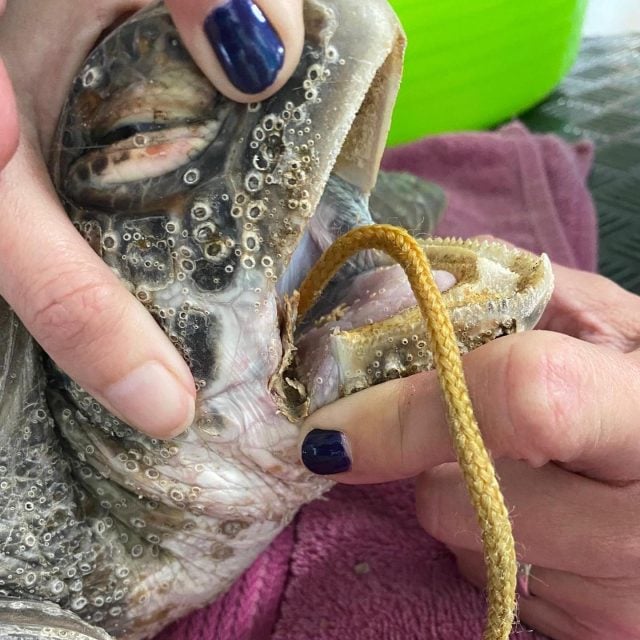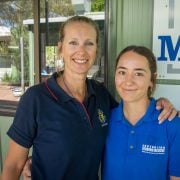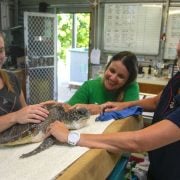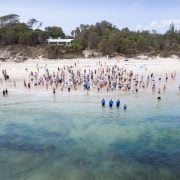
The Ballina Byron Sea Turtle Hospital, at Australian Seabird Rescue HQ in Ballina, is seeing more sick and injured sea turtles come into care than ever before.

This week Echonetdaily spoke to Assistant Manager Kelsey Banister, to find out more about what’s going on, and how people can help.
Ms Banister grew up in Byron Bay and studied marine science at SCU.
‘I always loved the ocean, grew up with the ocean, loved snorkelling, and it was actually my mum that first told me about Australian Seabird Rescue,’ she remembers.
She started volunteering with the non-profit organisation in 2013, together with her friend Olly Pitt, who also studied at SCU, and is now the General Manager.
‘We both had an interest in turtles and sea birds, and as soon as we came here, and looked at one of the tanks, we just immediately fell in love with the animals and wanted to help protect them.’

The legendary founder of Seabird Rescue, Lance Ferris, died in 2007.
‘There was a great concern about how this organisation was going to keep running, because he dedicated his whole life here,’ said Ms Banister.
But Seabird Rescue and the Turtle Hospital found new life thanks to the ‘amazing help’ of the Ballina and Byron community.
‘The volunteers here are the backbone of the organisation, and we wouldn’t be able to get through and do what we do without them,’ she said.
‘Now we are bigger than ever, we’re rescuing more and more animals. Last summer the most turtles we had at one time was 28!
‘From June last year to June this year we rescued 89 turtles, and that’s double from the previous year.’
So what’s going on?
Ms Banister said, ‘There are so many factors and it’s really hard to pinpoint it on one thing.

‘What we are thinking is there’s a lot of climate shifts, already. We are seeing some species of turtles we’ve never seen before. We even had a flatback turtle this year, and we’re seeing more and more green sea turtles.
‘I spend my time snorkelling the bay as well, and there’s more turtles than ever, which is great but not great as well.
‘We’re thinking a lot of the turtles are possibly getting sick and injured in other areas and then they’re moving down to our area.
‘Every year we see a really high influx of turtles coming to Brooms Head. We still don’t know why.
‘Last year we had six on one day at Brooms Head.
‘They get washed into the rock pools there, and a lot of them, if they’re healthy and fine they will swim out, and they’ll get washed out with the tide and they’re fine, but others are getting stranded on the beach, and they’re noticeably sick.
‘So our thinking is that they’re getting sick in other areas and getting washed down in the currents to Brooms.’
In terms of symptoms, Ms Banister said the turtles coming into care are ‘extremely emaciated, really skinny, and covered in barnacles, which don’t make the turtles sick themselves but they’re a really good indication that something internal is not right. It means they’re sick and slow-moving.

‘A lot of our turtles also have something called floating syndrome, that’s a build-up of gas in the turtle’s stomach, and it can be caused by heaps of reasons; plastic ingestion, parasite loads, other diseases.
‘It means the turtle’s unable to dive down.
‘It’s really sad, they’re floating on one side. This is how they get a good load of barnacles, because when they can’t go down to their cleaning stations, other animals aren’t able to eat the barnacles and get rid of them.
‘So we see a range of different issues. The Byron Bay Wildlife Hospital are our vets, and we’ve also worked with Lennox Head vets ever since Lance started up Seabird Rescue, so they’re really great.
‘But there’s still so many unknowns. Even when we do necropsies, like post-mortems on the turtles, sometimes it is still unclear what has gone wrong. Sometimes we send samples to labs, but climate change is definitely a factor, and poor water quality issues, disease problems, malnutrition definitely.’
Turtles moving south
Ms Banister said the flatback species comes from around the Bundaberg area, and many other species they see are more commonly found in Queensland, in areas increasingly affected by run-off, development and warming beaches. Echonetdaily asked if the turtles are also trying to nest locally.
‘Yes, we have a citizen science program in conjunction with National Parks and Australian Seabird Rescue called the NSW TurtleWatch Program, and we have a project officer now called Holly West. She’s originally from Coffs but she’s going up and down the coast at the moment training people on how to look out for turtle tracks,’ said Ms Banister.
‘We’ve had a few reports already of some turtles mating, off Hastings Point, and I’ve seen some pictures off Byron. That’s just unheard of. We’ve had a few nests in NSW and we predict that we will see more, especially the green sea turtles and loggerheads, but not so much the flatbacks yet.’

While Seabird Rescue doesn’t have the resources for satellite tracking, the turtles which come into care get titanium tags as part of National Parks licencing. Ms Banister said turtles occasionally come back into care, but generally results are very positive.
‘We treat every turtle differently, because they come in with so many different symptoms, but a lot of them need a good rest and recovery, so we feed them up.
‘Some go on medications, some don’t, that comes down to the vet’s advice. We will give them sometimes an antibiotic, but otherwise it’s all about good food, getting them strength and conditioning again, then getting them released.’
All the turtles that come into care are named. Current residents include Ernie, April, Stan and Champers.
We go through the alphabet like cyclones,’ explained Ms Banister. ‘It’s up to the volunteers what names they get!’
Help needed with food bills

Kelsey Banister told Echonetdaily, ‘The turtle hospital has got bigger over the years. We have a major sponsor here, called the Tony and Lisette Lewis Foundation.
‘They own the property and pay for any maintenance, but it’s up to us to do all the raising of funds for feeding the turtles and so on.
‘We are reliant on the public to keep running and make things better.’
Ms Banister said with so many turtles in care, they currently need extra help from the public to cover the costs of feeding the animals.
‘Yes, we just released four on Friday, but we have seventeen at the moment, and our food bills can be upwards of $2,000 a month,’ she said. ‘We need donations to help pay for that, because we’re preparing ourselves for a very busy summer! We’re seeing a turtle come in every couple of days at the moment, and we expect it to get a lot worse.’
You can securely donate through the Australian Seabird Rescue website.
Hungry turtles

While green turtles become fully herbivorous when they’re mature (that’s what gives their skin its green colour), most of the turtles in care are juveniles, which eat mostly high protein fish and squid to help with their recovery.
Ms Banister said, ‘We try to give them some greens here and there, but they’re like picky kids, and turn their nose up, unless we have a bigger one, but it’s pretty rare to have really big turtles in here.’
The turtles’ food is supplied by Northern Rivers Seafood in Ballina.
While there are no seabirds currently in care, Seabird Rescue say there is always see a steady increase of cases in the holidays. ‘Last holidays we had three pelicans in at one time with fishing-related injuries,’ said Ms Banister.
‘So just a reminder for people, if they’re enjoying their holidays, to fish responsibly, and if they do happen to entangle a bird, please give us a call. Don’t try to catch a bird yourself.’
She said it’s very important that hooks, lines and rubbish not be left in the environment. ‘Be careful of your surroundings. If you do see waste and litter around, just pick it up and take it away, even if it’s not yours, while being careful of course.’
Sea snakes too

Australian Seabird Rescue doesn’t just treat birds and turtles. ‘Yes we have sea snakes as well now,’ said Ms Banister.
‘They’re really venomous so we have to keep distance from them. There are trained snake handlers that are volunteers to work with them.
‘That’s a new thing for us, we’re learning more and more. They can be tricky to look after. They usually come into us in bad condition.
‘That’s definitely a climate shift thing we’re seeing as well. They usually get washed in after big seas. So they’ve been injured or sick out to sea and they get washed in.
‘But the turtles have a longer recovery process, so they’re more costly. The seabirds usually come in with injuries that are quite superficial, like line or hook, so they might get a few stitches and be in care for a couple of weeks. Our turtles can be in care for anywhere from three months to six months.’
Ms Banister said the turtles are rarely aggressive.

‘They’re pretty mellow usually, but they have very individual personalities. Some of them are really inquisitive, some of them don’t want anything to do with you, they just swim away.
‘Some are a bit aggressive towards each other, but we just separate them.’
When the turtles first come into the hospital, they go into small freshwater pools to rehydrate them and kill off barnacles and growth.
After emerging from quarantine, they go into larger and larger pools until they are strong enough to be released.
Teenaged (but not mutant ninja) turtles
Kelsey Banister said, ‘Most of the turtles that we get in care are juveniles, so they’re anywhere between five and twenty years old, and their maturity is at thirty years old.

‘They can’t reproduce until then, so this is why it’s so important why we do our job, because we want to get our turtles back into the population, reproducing.
‘There’s so many issues going on with turtles, and they’re endangered.
‘We got some comments in Facebook last week, with people wanting to know why we don’t leave the turtle to die on the beach, and let nature do its thing?
‘I totally understand that, but yes, sea turtles are an endangered species, so it’s important that we get them back out there.’
One of the reasons Australian Seabird Rescue has such a big job on its hands is the size of its territory, which goes from the Tweed right down to the Sandon River, keeping their volunteers and 4WD rescue vehicle busy.
Plastic just one of the problems
Ms Banister said when it comes to turtles, ‘There are so many issues. Plastic ingestion is a big one that everyone knows about, and we can pinpoint that. We seemed to be making progress there for a while but there are also issues with microplastics that we were unable to see.’
She explained that it’s not necessarily a death sentence if turtles eat plastic. ‘It depends on the size, so the ones we had in care possibly were sick from different issues, but once they’ve come into care we have the very glamorous job of sifting through their poo! And that’s how we find plastic.’
She said a turtle had recently been in care on the Central Coast, which ‘pooed out 2.5 metres of string which had a balloon attached to the end of it, and a plastic bag as well. Turtle rescuers around Sydney see a lot more plastic ingestion.
‘I don’t think plastic is our biggest issue up here. There’s just so many things. When you read papers about the issues with our turtles, a high percentage of what’s going on is still unknown.’

April is a turtle who was found by a young boy while fishing. She came into care after ingesting rope.
‘The Byron Bay Wildlife Hospital did amazing surgery to remove that,’ said Ms Banister.
‘They couldn’t pull the rope out of the turtle’s mouth because it was stuck further, so they actually cut her at the throat while she was under, and they removed all the rope.
‘She had stitches on her throat like Frankenstein, but she’s recovered really well. She’ll be released shortly.’
Volunteers crucial
Australian Seabird Rescue’s branches on the North Coast, Central Coast and South Coast of NSW all rely heavily on volunteers.
‘That’s the great thing about Australian Seabird Rescue, you can come and volunteer here with no needed experience,’ said Ms Banister.

‘You’ll learn everything here. At the moment we just took quite a few volunteers in, but if anyone is interested we always have a wait list going, because it fluctuates with people coming in.
‘We get a whole range of people coming here from all walks of life.
‘We have uni students that are doing marine science, there’s two boys out there from the Steiner School that are doing work experience with us. Our main volunteers are retirees that have spent their time in their careers but always had a passion for animals.
‘We have mums, we have teachers, we have tradies.’
What should people do if they see a turtle stranded on the beach this summer?
Kelsey Banister said, ‘Please call us on 0428 862 852, and don’t put a turtle back into the water. We’re 24/7. And one of our volunteers has the truck every day. Always call us if you see a turtle on the beach.
‘If you see a turtle stranded, it’s going to be for two reasons. Number one, if it’s a really big turtle it’s nesting, so you want to leave it alone and give it space. Definitely don’t put it back in the water.
‘Number two is they’re stranded because they’re sick or injured, so they’ve come up on the shore because they’re too weak to swim, and they’re possibly going to die or drown if they’re in the water for longer, so they need to be taken into care.
‘Avoid touching them and handling them, just give us a call and we will help.’
Can you visit Australian Seabird Rescue?

Ms Banister said, ‘We’re not open to the general public on a daily basis, because we’re running a very busy hospital here. But you can get in touch with us to organise group tours, and a tour in the school holidays as well.’
She said they will be running groups again after the New Year.
Until then, you can keep up with everything that’s happening on Australian Seabird Rescue’s Facebook page, including spectacular videos of turtle releases.
There’s also the Australian Seabird Rescue website here. You can make a secure donation from your computer or phone here.
More photos



























